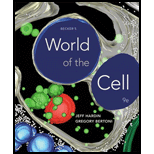
Becker's World of the Cell (9th Edition)
9th Edition
ISBN: 9780321934925
Author: Jeff Hardin, Gregory Paul Bertoni
Publisher: PEARSON
expand_more
expand_more
format_list_bulleted
Concept explainers
Textbook Question
Chapter 25, Problem 25.3PS
Telling Them Apart. Briefly describe how you might distinguish between each of the following pairs of phases in the same organism:
(a) Metaphase of mitosis and metaphase I of meiosis
(b) Metaphase of mitosis and metaphase II of meiosis
(c) Metaphase I and metaphase II of meiosis
(d) Telophase of mitosis and telophase II of meiosis
(e) Pachytene and diplotene stages of meiotic prophase I
Expert Solution & Answer
Want to see the full answer?
Check out a sample textbook solution
Students have asked these similar questions
Please help. Thanks!
Need help.
Please keep it short. Don't add a lot of information, thanks!
- Explain why it is important that meiosis converts diploid cells to haploid. Then briefly explain how meiosis does that, makes a diploid cell haploid.
Chapter 25 Solutions
Becker's World of the Cell (9th Edition)
Ch. 25 - Cloning can be done by somatic cell nuclear...Ch. 25 - If the DNA content of a diploid cell in the G1...Ch. 25 - Prob. 25.3CCCh. 25 - Prob. 1QCh. 25 - Prob. 25.4CCCh. 25 - What do you think would happen to a pathogenic...Ch. 25 - Prob. 25.6CCCh. 25 - The Truth About Sex. For each of the following...Ch. 25 - Ordering the Phases of Meiosis. Drawings of...Ch. 25 - Telling Them Apart. Briefly describe how you might...
Ch. 25 - Prob. 25.4PSCh. 25 - More about DNA. Let X be the amount of DNA present...Ch. 25 - Meiotic Mistakes. Infants born with Patau syndrome...Ch. 25 - Prob. 25.7PSCh. 25 - QUANTITATIVE Punnett Squares as Genetic Tools. The...Ch. 25 - QUANTITATIVE Genetic Mapping. The following table...Ch. 25 - Prob. 25.10PSCh. 25 - Prob. 25.11PS
Knowledge Booster
Learn more about
Need a deep-dive on the concept behind this application? Look no further. Learn more about this topic, biology and related others by exploring similar questions and additional content below.Similar questions
- Even experts make mistakes. Please point out the biggest mistake in the illustration below including the figure legend written by a sperm sorting guru and renowned scientist. How do you correct it?arrow_forwardMODIFIED TRUE OR FALSE. In the following items, read each statement carefully. I. Mitosis and meiosis are two cellular process that might be quite similar in terms of stages, but technically, different process that have two different functions. II. As an example, mitosis involves the production of genetically different daughter cells whereas meiosis involves the production of genetically identical daughter cells. a. The first statement (I) is correct and the second statement (II) is wrong b. The first statement (I) is wrong and the second statement (II) is correct c. Both statements are correct d. Both statements are wrong I. The continuity of life from one cell to another has its foundation in the reproduction of cells by way of the cell cycle.II. The cell cycle is an orderly sequence of events in the life of a cell from the division of a single parent cell to produce two new daughter cells and are highly conserved across eukaryotes.…arrow_forwardPlese help. Answer and explain.arrow_forward
- True or False. 1. a.) A diploid organism with 2N=8 would have 4 chromosomes in each gamete. b.) Homologous chromosomes do not pair up during asexual cell division. c.) Gametes have the same number of chromosomes as a somatic cell. d.) Cell division would not be possible without the work of DNA Polymerase. Pick one of the FALSE statements from the 4 previous questions and explain why it is incorrect.arrow_forwardCan you help?arrow_forwardExplain well. Not put answer.arrow_forward
- Still studying meiosis. How many chromosomes does a haploid cell have? In prophase II how many chromosomes does each daughter cell have?arrow_forwardMeiosis- a. Are the chromosomes at each pole during telophase 1 identical to chromosomes in the original cell (prior to S phase of cell cycle)? b. How about telophase 2?arrow_forwardsequence. Name each stage of mitosis, A to E. Each answer choice only once. used once and Picture A Metaphase [Choose ] Metaphase Anaphase Prometaphase Telophase Prophase Telophase Picture B Picture C Picture D Anaphase Picture El Promctaphasearrow_forward
- Let’s model mitosis. Focus on drawing the cell nucleus taking care to model the number and location of chromosomes. Although the chromosomes are only visible in each stage, draw them in all stages for clarity sake. Draw a 2n=4 cell at G1 of interphase. Draw the same cell at the start of prophase. Draw the same cell at metaphase. Draw the cell(s) that result at the end of cytokinesis. You can draw this out on paperarrow_forwardmultiple choice.arrow_forwardFill in the red numbers.arrow_forward
arrow_back_ios
SEE MORE QUESTIONS
arrow_forward_ios
Recommended textbooks for you
 Biology Today and Tomorrow without Physiology (Mi...BiologyISBN:9781305117396Author:Cecie Starr, Christine Evers, Lisa StarrPublisher:Cengage Learning
Biology Today and Tomorrow without Physiology (Mi...BiologyISBN:9781305117396Author:Cecie Starr, Christine Evers, Lisa StarrPublisher:Cengage Learning

Biology Today and Tomorrow without Physiology (Mi...
Biology
ISBN:9781305117396
Author:Cecie Starr, Christine Evers, Lisa Starr
Publisher:Cengage Learning
The Cell Cycle and its Regulation; Author: Professor Dave Explains;https://www.youtube.com/watch?v=eqJqhA8HSJ0;License: Standard YouTube License, CC-BY
Cell Division - Mitosis and Meiosis - GCSE Biology (9-1); Author: Mr Exham Biology;https://www.youtube.com/watch?v=w7vp_uRA8kw;License: Standard YouTube License, CC-BY